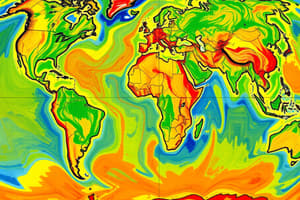Podcast
Questions and Answers
What is the purpose of the imaginary lines called parallels and meridians?
What is the purpose of the imaginary lines called parallels and meridians?
- To better understand the Earth's climate patterns
- To better understand the Earth's geography and location (correct)
- To divide the Earth into political boundaries
- To measure the Earth's distance from the Sun
What is the longest horizontal imaginary line that divides the Earth into the northern and southern hemispheres?
What is the longest horizontal imaginary line that divides the Earth into the northern and southern hemispheres?
- The tropic of cancer
- The arctic circle
- The tropic of capricorn
- The equator (correct)
What is the distance from any point on the planet to the equator called?
What is the distance from any point on the planet to the equator called?
- Latitude (correct)
- Parallel
- Meridian
- Longitude
What is the most important meridian that divides the Earth into the eastern and western hemispheres?
What is the most important meridian that divides the Earth into the eastern and western hemispheres?
Flashcards are hidden until you start studying
Study Notes
- Imaginary lines called parallels and meridians were created by earth scientists to better understand the Earth, with parallels encircling the planet from east to west.
- The equator is the longest horizontal imaginary line that divides the Earth into the northern and southern hemispheres, with other important parallels like the tropic of cancer, arctic circle in the northern hemisphere, and tropic of capricorn, antarctic circle in the southern hemisphere.
- The distance from any point on the planet to the equator is called latitude, measured in degrees from 0 to 90 for both northern (positive) and southern (negative) latitudes.
- Meridians are semi-circular imaginary lines running from the North Pole to the South Pole, with the Greenwich meridian being the most important, dividing the Earth into the eastern and western hemispheres.
- Longitude is the distance from any point on Earth to the Greenwich meridian, measured in degrees from 0 to 180 in both western (negative) and eastern (positive) hemispheres.
Studying That Suits You
Use AI to generate personalized quizzes and flashcards to suit your learning preferences.




